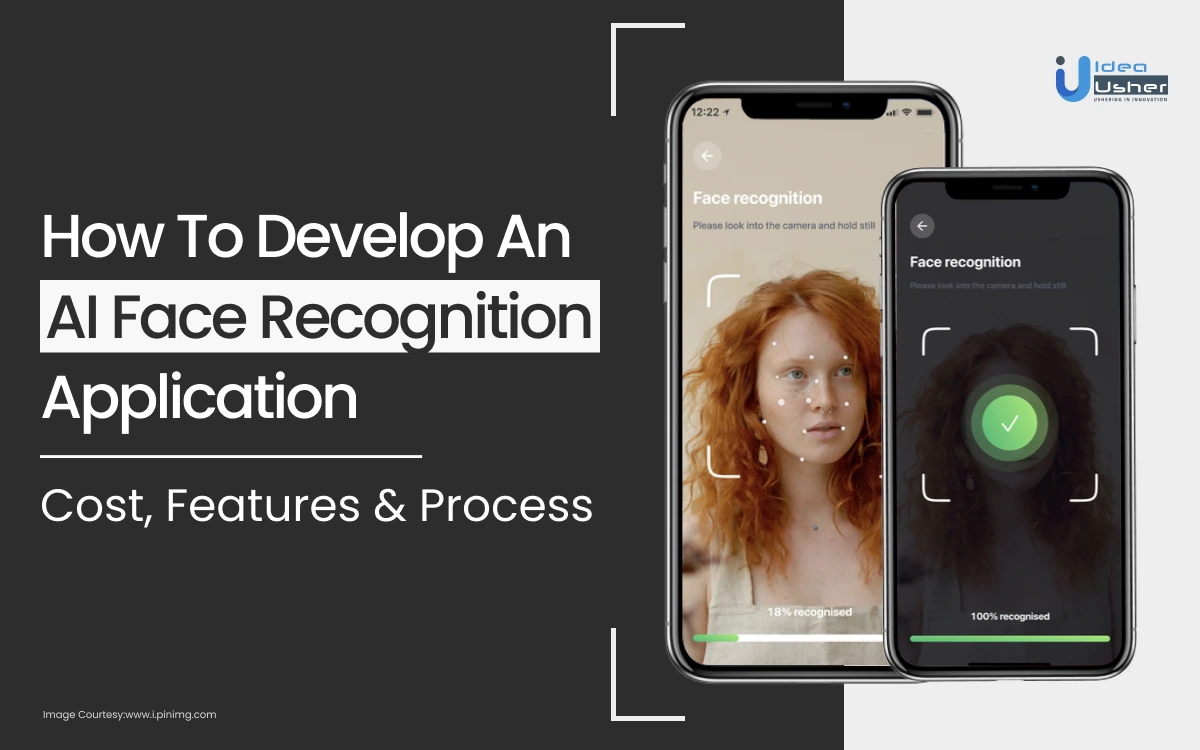- What Is An AI-Based Facial Recognition?
- How Facial Recognition Works?
- Business Benefits Of Utilizing AI Face Recognition
- Technologies For An AI Face Recognition App Development
- Examples Of Face Recognition Applications
- Must-Have Features In An AI Face Recognition App
- How To Develop An AI Face Recognition App?
- Cost Affecting Factors To Consider To Develop An AI Face Recognition App
- 1. Programming Languages
- Conclusion
- How Can We Help In Developing An AI Face Recognition App?
- FAQ

In recent years, facial recognition technology has surged in popularity as a biometric authentication method across various applications.
Leveraging deep learning algorithms, this software analyzes and compares facial features to accurately identify individuals.
There are a lot of business opportunities due to the rising market for facial recognition technology and the tremendous inspiration behind its adoption by industries, defense sectors, and governmental organizations globally.
For the organization’s internal support, attendance tracking, and security, the facial recognition system works incredibly well.
In order to make facial recognition software solutions secure for the future, businesses are combining emerging technologies like blockchain, AI, AR, and VR.
Discover how to develop an AI face recognition software by with this blog, which covers a variety of crucial topics like development procedures, cost-affecting variables, necessary features, and more.
- What Is An AI-Based Facial Recognition?
- How Facial Recognition Works?
- Business Benefits Of Utilizing AI Face Recognition
- Technologies For An AI Face Recognition App Development
- Examples Of Face Recognition Applications
- Must-Have Features In An AI Face Recognition App
- How To Develop An AI Face Recognition App?
- Cost Affecting Factors To Consider To Develop An AI Face Recognition App
- 1. Programming Languages
- Conclusion
- How Can We Help In Developing An AI Face Recognition App?
- FAQ
What Is An AI-Based Facial Recognition?
AI-based facial recognition is a technology that uses artificial intelligence algorithms to identify and authenticate individuals based on their facial features. It works by analyzing unique patterns in the person’s facial characteristics, such as the distance between the eyes, the shape of the nose, and the contours of the jawline.
AI algorithms are trained on vast datasets of facial images to learn and recognize patterns, allowing the system to accurately match faces to stored identities or detect and classify faces in real-time.
One of the key components of AI-based facial recognition is deep learning, a subset of artificial intelligence that involves training neural networks with large amounts of data to perform specific tasks.
Deep learning algorithms are particularly well-suited for facial recognition because they can automatically extract relevant features from images and make accurate predictions based on those features.
How Facial Recognition Works?
The facial recognition process consists of four stages: image capture, data extraction, pattern comparison, and matching. Initially, the program captures a face image, then extracts necessary data, compares patterns with stored ones, and determines matches. The detailed working are as follows
1. Capture
The process begins with the facial recognition system capturing an image of a face, which serves as the primary input for analysis. Utilizing various devices such as cameras on smartphones or accessing stored images, the system obtains visual data necessary for identification.
2. Extraction
Following the capture stage, the system extracts essential facial features and patterns from the acquired image. This involves complex algorithms that analyze the captured data to identify unique characteristics and attributes specific to the individual’s face. Through sophisticated image processing techniques, relevant information is isolated and prepared for comparison.
3. Comparison
Once the facial features are extracted, the system proceeds to compare these patterns with existing data stored in its database. This involves a meticulous process where the system matches the extracted features against previously recorded facial profiles. By evaluating similarities and disparities, the system determines potential matches or discrepancies.
4. Matching
In the final stage, the system concludes the recognition process by identifying a match from the database, if any. Upon finding a suitable match, the system provides the corresponding information to the user who initiated the request. This conclusive step marks the completion of the facial recognition process, offering users relevant insights based on the identified match.
Business Benefits Of Utilizing AI Face Recognition
Discover the compelling advantages of integrating facial recognition technology into your business operations. Explore how this innovation can optimize processes and elevate customer experiences, driving growth and efficiency.
1. Contactless Identification
Implementing facial recognition technology for identification purposes offers the advantage of contactless interaction. Compared to traditional fingerprint scanners, facial recognition is notably faster, making it particularly advantageous in high-traffic areas or workplaces with a large number of employees.
2. Recognition Speed Enhancement
Facial recognition technology has significantly advanced over the years, resulting in faster and more efficient recognition processes. With minimal time required for identification, especially when individuals’ biometric data is already stored in the system, businesses can benefit from swift and seamless operations.
3. Enhanced Security Measures
Facial recognition systems bolster security measures in various settings, including public venues like stadiums, hospitals, and shopping malls. By accurately distinguishing between authorized personnel and unauthorized individuals, these systems contribute to maintaining secure environments and safeguarding valuable assets.
4. Automation of Verification Processes
By automating verification processes through facial recognition technology, businesses can optimize resource allocation and reduce the need for additional personnel. With the system operating continuously, organizations can redirect manpower to other essential tasks, enhancing overall efficiency.
5. High Accuracy Rates
Facial recognition systems leverage intricate facial structures to achieve high levels of accuracy in identification. The technology’s constant evolution and improvements in camera capabilities further enhance accuracy rates, making it challenging to manipulate or deceive the system effectively. As a result, businesses can rely on precise identification outcomes for various applications.
Technologies For An AI Face Recognition App Development
Developing a next-gen AI face recognition app involves leveraging cutting-edge technologies across various domains such as artificial intelligence, computer vision, machine learning, and data security. Here are some key technologies and approaches you might consider:
1. Deep Learning Models
In the development of a next-generation AI face recognition app, one of the fundamental components is the utilization of deep learning models. These models, such as ResNet, EfficientNet, or MobileNet, serve as the backbone for feature extraction and classification. By experimenting with various architectures, developers can strike a balance between model complexity and performance, ensuring optimal recognition accuracy.
2. Generative Adversarial Networks (GANs)
Another cutting-edge technology to consider is Generative Adversarial Networks (GANs). These networks can play a crucial role in augmenting training data by generating synthetic face images. Variants such as Conditional GANs (cGANs) or Progressive Growing GANs (PGGANs) offer avenues to produce high-quality synthetic images, effectively expanding the diversity of the training dataset.
3. Face Recognition
To enhance the robustness of face recognition systems, integrating 3D face recognition techniques is essential. These techniques leverage depth-sensing technologies such as structured light or Time-of-Flight (ToF) sensors to capture three-dimensional facial information. By incorporating 3D data, the system becomes more resilient to variations in lighting conditions and pose, leading to improved recognition accuracy.
4. Face Detection and Alignment
Accurate face detection and alignment are crucial steps in the face recognition pipeline. Advanced face detection algorithms such as MobileNet SSD or YOLO (You Only Look Once) offer real-time performance suitable for resource-constrained devices. These algorithms ensure precise localization of faces in varying conditions, including occlusions and scale variations. Robust face alignment techniques are also essential to ensure that facial features are properly aligned for accurate feature extraction, laying the foundation for reliable face recognition.
5. Facial Landmark Detection
Facial landmark detection plays a key role in precisely locating key facial landmarks such as eyes, nose, and mouth. Techniques such as cascaded regression or heatmap regression methods are commonly used for accurate landmark localization. Additionally, incorporating facial action unit detection can capture subtle facial expressions, providing valuable information for improving recognition performance. Accurate detection of facial landmarks enables the extraction of discriminative features necessary for robust face recognition.
6. Feature Extraction
Feature extraction is a critical aspect of face recognition, enabling the system to learn discriminative facial features. Techniques such as Siamese networks or triplet loss functions are employed for feature extraction, allowing the model to learn robust representations of facial features. By utilizing these techniques, the system can effectively capture and encode the unique characteristics of each individual’s face, facilitating accurate recognition across varying conditions.
7. Attention Mechanisms
Attention mechanisms play a vital role in allowing the model to focus on informative regions of the face during feature extraction. Self-attention mechanisms, such as those found in Transformer models, capture long-range dependencies in facial features, enhancing recognition accuracy. Additionally, spatial and channel-wise attention mechanisms enable the model to attend to specific facial regions and feature channels relevant to recognition, further improving efficiency and performance.
8. Transfer Learning and Fine-tuning
Leveraging pre-trained models on large-scale face recognition datasets and fine-tuning them on specific datasets can significantly accelerate training and improve performance. Domain adaptation techniques allow for the transfer of knowledge from related domains, such as general object recognition, to improve face recognition performance. Multi-task learning frameworks can also be explored to jointly optimize for related tasks, such as facial attribute prediction or facial expression recognition, alongside face recognition, leading to a more comprehensive and robust system.
9. Privacy-Preserving Techniques
In the context of face recognition, privacy-preserving techniques are crucial to protect users’ sensitive facial data during model training and inference. Homomorphic encryption techniques enable secure computations on encrypted facial data while preserving privacy, ensuring that sensitive information remains protected throughout the process. Adversarial training can mitigate model inversion attacks and membership inference attacks, further enhancing the privacy and security of the face recognition system. By implementing these techniques, developers can build trust and confidence among users regarding the protection of their personal data.
Examples Of Face Recognition Applications
Before developing an app for Android or iOS that includes face recognition, it is critical to research how others have approached this difficulty. To help with this, we’ve produced a selection of the best face recognition applications that can serve as useful examples. Let us go into them for examination.
1. FaceLock
FaceLock stands out as a complimentary facial recognition application designed for Android users, prioritizing enhanced security measures. Serving as a trailblazer in facial recognition technology, FaceLock empowers users to safeguard specific applications and confidential files behind a personalized facial lock mechanism. The app boasts a user-friendly interface that can be seamlessly tailored to individual preferences. Furthermore, FaceLock offers both a basic free version and a premium version with extended functionality.
2. MojiPop
The MojiPop app, developed by Eureka Studios, is available for both Android and iOS platforms at no cost. It distinguishes itself by offering users a diverse array of animated stickers that dynamically adapt to facial recognition technology (FRT). The app features a straightforward architecture, characterized by intuitive navigation and an interactive keyboard that enhances user engagement.
3. Applock
Applock emerges as one of the premier facial recognition applications for Android, particularly renowned for its robust security features. With the ability to restrict unauthorized access to personal information and applications, Applock provides users with a comprehensive security solution. Leveraging both voice and facial recognition capabilities, this app offers convenient access to mobile devices while ensuring data protection.
4. FindFace
FindFace, an Android-based facial recognition app, introduces a novel concept allowing users to upload photos of strangers and locate them on social networks. While primarily intended for entertainment purposes, FindFace delivers impressive accuracy, boasting a 95% success rate and the capability to analyze 250 million faces in under half a second. Additionally, the developers have introduced a cross-platform API, facilitating integration with mobile and web applications.
5. Facial Metrics Analysis Pro
Facial Metrics Analysis Pro represents another intriguing application of facial recognition technology, catering to the realm of entertainment. This Android-based app analyzes facial metrics to identify celebrity resemblances, offering users an entertaining and interactive experience.
6. FaceFirst
FaceFirst emerges as a prominent facial recognition tool primarily utilized by law enforcement agencies and transportation hubs for remote identification purposes. With a comprehensive database and real-time notification features, FaceFirst streamlines the facial recognition process, facilitating efficient identification and tracking of individuals.
7. LuxandFace Recognition
LuxandFace Recognition, an Apple-exclusive facial recognition app, specializes in people identification by allowing users to assign names to recognized faces. Despite its relatively basic functionality, this app serves as a reliable tool for personal identification and management of recognized individuals.
Must-Have Features In An AI Face Recognition App
The basic feature of facial recognition software is to identify individuals based on their traits like unique identification and different identity. The basic features of face recognition software supports fingerprint verification, eye recognition, hand geometry recognition, voice recognition, card recognition, and signature recognition.
1. Multi-Verification Methods
The AI Face Recognition App boasts versatility with support for various verification methods, ensuring adaptability to diverse user preferences. From traditional fingerprint and eye recognition to advanced hand geometry, voice, card, and signature recognition, the app provides a comprehensive range of options to cater to individual user needs, making it a versatile and user-friendly solution.
2. Live Facial Recognition (LFR)
The app’s Live Facial Recognition feature utilizes cutting-edge technology, leveraging multiple camera feeds to continuously scan and compare faces against a predefined database of identities. This real-time functionality enhances security by promptly alerting administrators when a matched face is detected, making it an invaluable tool for surveillance, access control, and event monitoring.
3. Multiple Face Readability
Designed to meet the demands of organizations with a growing number of members, the app’s Multiple Face Readability feature can handle up to 10,000 faces simultaneously. This capability is particularly useful for large enterprises or institutions, providing efficient face management through a prominent LCD display. It ensures seamless identification and tracking of individuals in high-traffic scenarios.
4. Multiple Modes of Facial Recognition
Enhancing security through flexibility, the app supports three distinct facial verification methods – face, card, or a combination of both. This multi-mode approach empowers users to tailor the verification process according to their specific security requirements. It introduces an additional layer of authentication, reinforcing the system’s robustness against unauthorized access attempts.
5. Remote Upgrade Capability
Recognizing the evolving needs of small organizations and startups, the app offers a Remote Upgrade feature. This functionality allows users to update the software seamlessly through integration with the app’s interface. This remote upgrade capability ensures that organizations can stay current with the latest features and security enhancements without the need for physical intervention, saving time and resources.
6. Cloud-DB Approach
Addressing scalability concerns, the app adopts a Cloud-DB Approach. This allows the system to accommodate an ever-expanding number of faces in the database, with the flexibility to upgrade limits to 20,000 faces or more. Leveraging cloud technology ensures that the app can handle growing datasets efficiently, providing a robust solution that can scale alongside the evolving needs of the organization.
How To Develop An AI Face Recognition App?
Developing face recognition software requires meticulous planning and systematic attention to crucial details to ensure consistency and reliability. In this guide, we’ll outline the essential steps involved in creating such software.
1. Define Purpose, Scope, and Use Cases
Developing a face recognition app necessitates a clear understanding of its intended purpose, scope, and potential use cases. Without a defined purpose, it becomes challenging to delineate the app’s scope and anticipate its functionalities accurately. Moreover, identifying specific scenarios relevant to the target audience is crucial for tailoring the app to meet their needs effectively.
2. Gather Training Data and Check for Accuracy
A foundational step in face recognition app development is the acquisition of training data and ensuring its accuracy. Given the complexity of facial recognition technology, it is imperative to curate a diverse dataset comprising facial images that encompass a wide range of demographics, lighting conditions, poses, and expressions. Additionally, thorough validation of the training data is essential to ensure that it accurately represents the intended user base and minimizes biases that may affect recognition performance.
3. Select Facial Recognition Algorithm
Choosing the appropriate facial recognition algorithm is pivotal to the success of the app. Various algorithms, such as Fisherfaces, Local Binary Patterns, Eigenfaces, and Deep Learning-based methods like Convolutional Neural Networks (CNNs), offer different strengths and capabilities. Evaluating these algorithms based on factors like performance metrics, scalability, computational efficiency, and compatibility with the dataset is crucial for selecting the most suitable one for the application’s requirements.
4. Implement Preprocessing Techniques
Preprocessing techniques play a crucial role in preparing facial images for accurate recognition. These techniques, including face detection, alignment, noise reduction, illumination correction, and feature extraction, are essential for enhancing the quality of input data before it is fed into the recognition algorithms. Careful consideration should be given to selecting the most appropriate preprocessing techniques based on the specific use cases and characteristics of the dataset to optimize recognition performance.
4. Train and Tune the Recognition Model
Training and fine-tuning the recognition model are iterative processes aimed at optimizing its performance. Utilizing the labeled dataset, the model is trained to recognize facial features accurately. Subsequently, rigorous testing and validation are conducted to evaluate its performance under various conditions. Fine-tuning the model parameters based on the testing results enables continuous improvement and refinement, ultimately enhancing the app’s recognition capabilities.
5. Address Privacy, Security, and Ethical Considerations
Ensuring privacy, security, and ethical considerations are integral aspects of face recognition app development. Compliance with relevant data protection regulations, such as GDPR or CCPA, is paramount to safeguarding user data. Implementing privacy-enhancing measures, such as data encryption, secure storage, and access controls, helps mitigate security risks associated with facial image datasets. Moreover, addressing potential biases in the dataset and algorithm promotes ethical use of the technology, fostering transparency and trust among users.
Cost Affecting Factors To Consider To Develop An AI Face Recognition App
Developing an AI face recognition app involves careful consideration of several key factors that can significantly impact the overall cost and success of the project. Let’s understand into each aspect:
1. Type of Facial Recognition Software
The choice between traditional algorithms and advanced deep learning models like Convolutional Neural Networks (CNNs) not only impacts development complexity but also influences ongoing maintenance efforts. Traditional algorithms may require less computational power but might lack the accuracy and robustness of deep learning models. On the other hand, deep learning models necessitate significant computational resources for training and inference, potentially increasing infrastructure costs.
2. Integrated Features
The complexity of integrating features such as real-time recognition, emotion detection, age estimation, and gender classification varies based on the accuracy and performance requirements. For instance, real-time recognition demands efficient algorithms and optimized processing pipelines to handle video streams effectively. Similarly, incorporating emotion detection or age estimation functionalities may involve additional training data and algorithm fine-tuning, affecting development costs.
3. Required Tech Stack
Choosing the appropriate technology stack involves evaluating factors such as scalability, performance, and compatibility with third-party services. Opting for widely adopted frameworks and libraries can streamline development efforts by leveraging existing functionalities and community support. However, custom requirements or performance constraints may necessitate the development of certain components from scratch, potentially increasing development time and costs.
4. Location of the Software Development Company
The choice between onshore, nearshore, or offshore development teams involves trade-offs between cost savings and communication efficiency. While offshore development teams typically offer lower labor rates, potential challenges such as language barriers, timezone differences, and cultural nuances may impact project coordination and increase the likelihood of miscommunication. Conversely, onshore development teams often provide better alignment in terms of language and culture but may incur higher labor costs.
5. Team Expertise
The expertise and experience of the development team are crucial factors in ensuring the successful implementation of AI face recognition technology. A team with specialized knowledge in AI, machine learning, and computer vision can navigate challenges more effectively, potentially reducing development iterations and associated costs. Additionally, ongoing training and professional development initiatives may be necessary to stay abreast of evolving technologies and best practices, contributing to long-term project success.
6. Project Duration
The project duration not only affects development costs but also impacts time-to-market and competitive advantage. Balancing project timelines with resource allocation is essential to minimize costs while ensuring timely delivery. Accelerated development schedules may require additional resources to meet deadlines, potentially increasing costs, while extended timelines may lead to budget overruns due to prolonged resource utilization and shifting market dynamics.
7. Add-on Features
Incorporating add-on features beyond core face recognition functionality introduces additional development complexities and considerations. Integration with third-party APIs, for example, requires compatibility testing and potential adjustments to ensure seamless interoperability. Similarly, implementing custom analytics dashboards or robust data privacy features may involve significant development efforts, impacting both project timelines and budgets. Therefore, careful prioritization of add-on features is essential to align with project goals and budget constraints.
Tech Stack To Consider To Develop An AI Face Recognition App
To develop an AI face recognition app, you’ll need to consider several components in your tech stack. Here’s a breakdown of the tech stack:
1. Programming Languages
- Python: Widely used for AI and machine learning tasks due to its extensive libraries and frameworks.
- JavaScript (for web apps): If you’re developing a web-based application, you may need JavaScript for frontend development.
2. Machine Learning Frameworks
- TensorFlow: Developed by Google, TensorFlow is one of the most popular frameworks for building machine learning models, including those for face recognition.
- PyTorch: Developed by Facebook, PyTorch is known for its dynamic computation graph, making it suitable for research-oriented projects and prototyping.
- OpenCV: A computer vision library that provides tools for image processing, including face detection and recognition.
3. Face Detection and Recognition Libraries
- Dlib: Dlib is a C++ library with Python bindings, offering tools for face detection and shape prediction, which can be used in conjunction with deep learning for face recognition.
- OpenCV: OpenCV provides pre-trained models for face detection, and you can implement face recognition algorithms using its tools.
4. Deep Learning Models
- Convolutional Neural Networks (CNNs): These are commonly used for image-related tasks, including face recognition. Architectures like ResNet, VGG, or custom CNNs can be used.
- Siamese Networks: These networks are designed for one-shot learning tasks like face recognition, where they learn to differentiate between similar and dissimilar pairs of images.
5. Database
- SQL or NoSQL: Depending on your application’s needs, you may choose a SQL (e.g., PostgreSQL, MySQL) or NoSQL (e.g., MongoDB) database for storing user data, including face embeddings or feature vectors.
6. Cloud Services (Optional, but may be useful for scalability and deployment)
- AWS, Azure, Google Cloud: These platforms offer various services for deploying machine learning models, including containerization with Docker, and scalable computing resources.
7. Frontend Frameworks (for web-based applications)
- React, Angular, Vue.js: These frameworks can be used for building user interfaces and integrating with backend services for a web-based face recognition application.
8. Additional Tools and Libraries
- Numpy, Pandas: For data manipulation and processing.
- Flask, Django: Web frameworks for building backend services and APIs.
- JWT (JSON Web Tokens): For handling authentication and securing API endpoints.
Conclusion
The increasing popularity of facial recognition technology has undoubtedly brought convenience to various aspects of daily life. From unlocking smartphones to enhancing security systems, its applications are diverse and impactful.
However, the development procedure for this technology is complicated and complex. Simply developing a facial recognition program is insufficient to ensure excellent functionality. Beyond the initial research phase, there is a critical need to train AI-powered software to reliably detect faces inside large databases.
The implementation of facial recognition technology requires a trustworthy technological partner. In addition to being skilled in software development, this partner should be well-versed in all aspects of facial recognition algorithm training.
Working together with such a partner guarantees that the software is customized to match the unique requirements and goals of the company, thereby promoting its expansion and profitability.
How Can We Help In Developing An AI Face Recognition App?
We specialize in developing cutting-edge AI solutions, and when it comes to creating an AI face recognition app, our expertise truly shines. With a dedicated team of skilled developers and engineers,
We can leverage state-of-the-art facial recognition algorithms and machine learning techniques to build a highly accurate and efficient app. From initial concept ideation to final deployment, Connect with us now by clicking the Button Below.
FAQ
Q. What are the primary benefits of integrating AI face recognition into business operations?
A. Integrating AI face recognition offers numerous benefits, including enhanced security measures, streamlined authentication processes, improved customer experiences, efficient access control, valuable data insights, and the potential for personalized marketing strategies based on customer demographics.
Q. How does AI face recognition enhance security within a business environment?
A. AI face recognition provides a robust layer of security by accurately identifying individuals, preventing unauthorized access to sensitive areas or data, reducing the risk of identity fraud, and facilitating quick response to security breaches through real-time alerts.
Q. Can AI face recognition be seamlessly integrated into existing systems and processes?
A. Yes, AI face recognition technology is designed to be highly adaptable and can be integrated into various systems and processes with minimal disruption. Our team will work closely with your IT department to ensure a smooth integration tailored to your specific requirements.
Q. How does AI face recognition comply with data privacy regulations and protect user information?
A. AI face recognition solution prioritizes data privacy and security, adhering to strict regulatory standards such as GDPR and ensuring that user data is encrypted, anonymized, and stored securely. Additionally, access controls are implemented to restrict data access only to authorized personnel.
Q. How can AI face recognition contribute to improving customer experiences and engagement?
A. By leveraging AI face recognition, businesses can offer personalized experiences to customers, such as tailored recommendations, efficient check-in processes, and targeted marketing campaigns based on demographic information. This not only enhances customer satisfaction but also fosters long-term loyalty and engagement.













Gaurav Patil